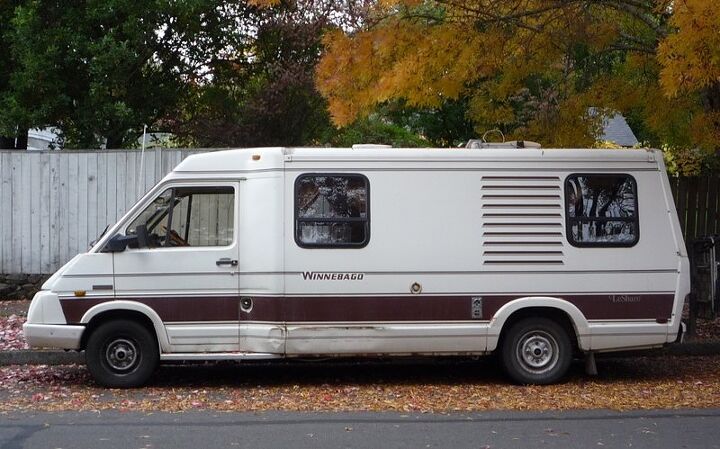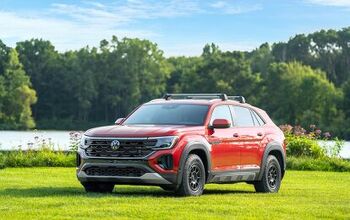Curbside Classic: 1985 Winnebago 23mpg LeSharo Turbo Diesel RV

Like cars, or even more so, the quest to find fuel efficiency in RVs has come and gone with the price of fuel. In the early eighties, when gas was around $4.00 in today’s dollars, the RV business crashed and desperately looked for a radical solution. One could say that the Winnebago LeSharo was the equivalent of the 1985 Cadillac DeVille: downsized to the extreme. Winnebago desperately searched for the solution, and found it in…France. LeSharo: the LeCar of RVs.
The LeSharo was one of those great ideas that ran aground on the realities of its Renault engine and transmission. Renault had just recently introduced its new FWD diesel Traffic van. Winnebago bit, and another Franco-American tie-up was created, and Renault shipped cabs complete with front drive train, and a rear axle to Winnebago, where the low and light (5,000 lb) 1983 LeSharo was born. The economy (20-23 mpg) was enticing; the Renault engine and transmission less so.
It may have worked ok in a small van delivering baguettes in Paris, but the 57 hp 2.1 L diesel four was overwhelmed by American standards. In 1984, a 75 hp turbocharged version was quickly rushed into service. But numerous and severe problems with both the engine and the four-speed manual transaxle necessitated abandoning it. By 1986, the diesel was out, and Renault’s 2.2 liter gas four (as used in their US cars) and a three-speed automatic transmission were in. mileage was more like 16-19 mpg. With the proper knowledgeable attention, they can be made to last reasonably well.
This combination was relatively more reliable, but lacked the diesel’s ultimate efficiency potential. The one I found here has the turbo-diesel stickers on the back, but since many were re-powered, its hard to say for sure. On the other hand, Eugene is the final destination of many old orphan diesels, so my guess it’s in the hands of a hard-core LeSharo TD fan. For those LeSharo lovers that are sick of the Renault issues, there is an outfit that does a regular business transplanting Chrysler 3.3 V6 minivan drive trains into these.
The LeSharo petered out in 1992, but was reincarnated in 1994 as the Rialta, now using a complete VW Eurovan front cab and drive train. The early versions used the 2.5 liter five, so it wasn’t exactly brimming with power either. Eventually, the VR6 engine was the definitive version. It appears to have gone out of production some time in the last few years, as Sprinter-based conversions and RVs offer real stand-up headroom and diesel economy.

More by Paul Niedermeyer
Latest Car Reviews
Read moreLatest Product Reviews
Read moreRecent Comments
- AMcA My theory is that that when the Big 3 gave away the store to the UAW in the last contract, there was a side deal in which the UAW promised to go after the non-organized transplant plants. Even the UAW understands that if the wage differential gets too high it's gonna kill the golden goose.
- MKizzy Why else does range matter? Because in the EV advocate's dream scenario of a post-ICE future, the average multi-car household will find itself with more EVs in their garages and driveways than places to plug them in or the capacity to charge then all at once without significant electrical upgrades. Unless each vehicle has enough range to allow for multiple days without plugging in, fighting over charging access in multi-EV households will be right up there with finances for causes of domestic strife.
- 28-Cars-Later WSJ blurb in Think or Swim:Workers at Volkswagen's Tennessee factory voted to join the United Auto Workers, marking a historic win for the 89- year-old union that is seeking to expand where it has struggled before, with foreign-owned factories in the South.The vote is a breakthrough for the UAW, whose membership has shrunk by about three-quarters since the 1970s, to less than 400,000 workers last year.UAW leaders have hitched their growth ambitions to organizing nonunion auto factories, many of which are in southern states where the Detroit-based labor group has failed several times and antiunion sentiment abounds."People are ready for change," said Kelcey Smith, 48, who has worked in the VW plant's paint shop for about a year, after leaving his job at an Amazon.com warehouse in town. "We look forward to making history and bringing change throughout the entire South." ...Start the clock on a Chattanooga shutdown.
- 1995 SC Didn't Chrysler actually offer something with a rearward facing seat and a desk with a typewriter back in the 60s?
- The Oracle Happy Trails Tadge





































Comments
Join the conversation
One of the problems is the cost of storing any RV or motor home. In my area this is not a small expense. If you live in an unincorporated area, this is no problem. But for those of us that live in 'Cities' it can be very expensive and very inconvenient.
The VW based Rialta and the pop top camper that replaced the Westfalias went out of production at the end of 2003 with the VW Eurovan when VW introduced a new generation of transporter and didn't bother to sell it in the US. As a side issue VW moved away from Westfalia conversions after Daimler bought them in 1999.